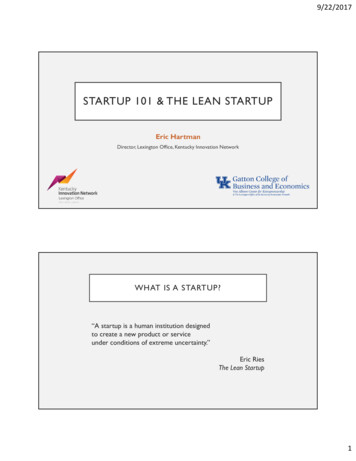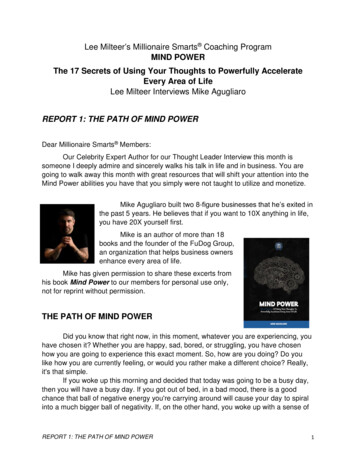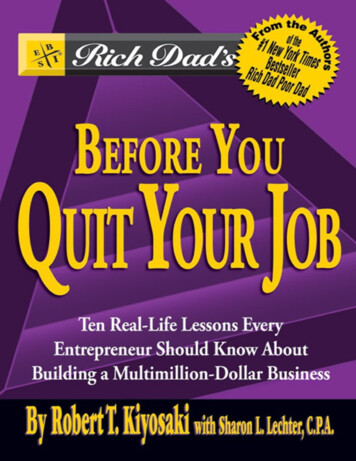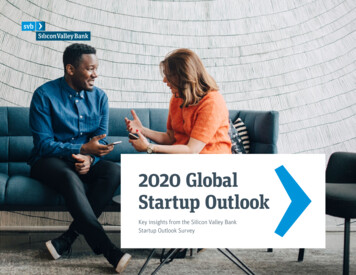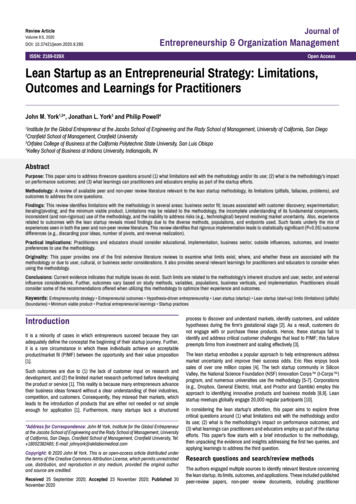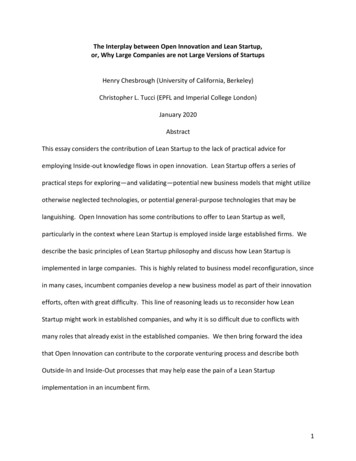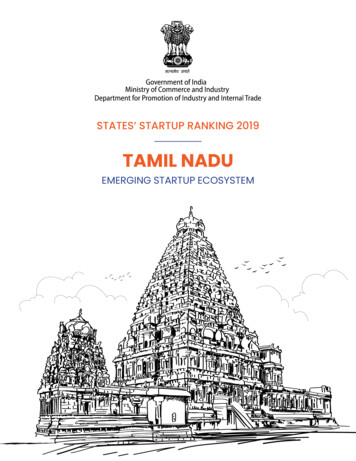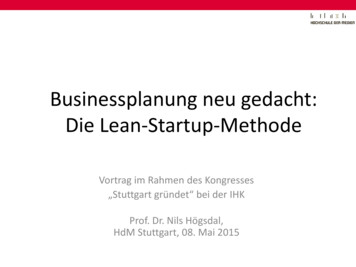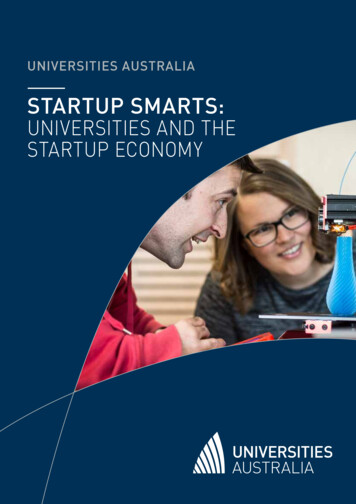
Transcription
UNIVERSITIES AUSTRALIASTARTUP SMARTS:UNIVERSITIES AND THESTARTUP ECONOMY
Published in March 2017This work is licensed under a CreativeCommons Attribution 4.0 International Licence.Further inquiries should be made to theChief Executive:GPO Box 1142, Canberra ACT 2601T 61 2 6285 8100F 61 2 6285 8101E contact@universitiesaustralia.edu.auW universitiesaustralia.edu.auABN 53 008 502 930Universities and their graduates are the driving force in Australia’s startup economy2U N I V ER SI TI ES AU STR AL I A S TA R T UP SM A RT S: UN I V E RSI T I E S A N D T H E STA R T UP E C O N O MY
FOREWORDOver the past decade, the startup economy has become an important part of Australia’sstrategy for economic diversification and new growth.Yet what has not been widely understood is the extent to which universities and theirgraduates are responsible for that growth.Now, for the first time, this joint project between Universities Australia and Startup Mustertakes a closer look at the data.It confirms that universities and their graduates are the driving force in Australia’sstartup economy.Drawing on the Startup Muster 2016 survey of startup founders, this snapshot puts somehard numbers on precisely how crucial universities are to Australia’s startup economy.It finds that more than four in five Australian startup founders are universitygraduates.Many startups, too, have been nurtured into existence by a university incubator, accelerator,mentoring scheme or entrepreneurialism course.Such programs provide support, physical space and direct access to the latest researchand expertise to help great Australian ideas grow into great Australian businesses. Thereare now more than 100 of these facilities at Australian universities.Universities have reshaped course offerings, programs and facilities to equip the nextgenerations of graduates with the skills they need to start their own enterprises.This report also includes case studies of startup founders.If we want to see even more startups founded in the years ahead, universities will beat the very centre of making that a reality.Universitiesand theirgraduatesare thedriving forcein Australia’sstartupeconomy.Professor Barney GloverChairUniversities AustraliaMonica WulffCEO and Co-founderStart Up MusterBelinda RobinsonChief ExecutiveUniversities AustraliaU N I V ER SI TI ES AU STR AL I A S TA RT UP SM A R T S: UN I V E R SI T I E S A N D T H E STA RT UP E C O N O M Y3
CONTENTSA record 568 million was raised by Australian startups in 20164U N I V ER SI TI ES AU STR AL I A S TA R T UP SM A RT S: UN I V E RSI T I E S A N D T H E STA R T UP E C O N O MY
OVERVIEWAustralia’s economy is in the midst of a seismic shift.By the timetoday’skindergartenstudentsfinish highschool andstart applyingfor university,startups willhave createdover halfa millionnew jobsacross thecountry.Key economic forecasts suggest that 40 per cent of today’s jobs will not exist within twodecades.Today’s school leavers are expected to have an average of 17 different jobs and up to fivecareer changes over their lifetime.1Against this backdrop, universities have a crucial role to help millions of Australians upskilland reskill throughout their working lives.Amidst such structural shifts, the potential to create new jobs in startup businesses that usetechnology to reach local and global markets is immense.By the time today’s kindergarten students finish high school and start applying for university,startups will have created over half a million new jobs across the country.2And this new sector of the economy is already starting to attract significant investment.A record 568 million was raised by Australian startups in 2016—73 per cent morethan in the previous year.3Australia’s universities are the essential ingredient to expand this promising part of oureconomy.“You’ve heard of Akron—one of the smartest places on earth? You hadfour old tyre companies gone practically overnight, a life-threateningchallenge, then a second element, the president of the university LuisProenza, who got people together to collaborate because they had noother choice, and what stayed in Akron was the world class polymerresearch that has given us things like contact lenses that change colourif you have diabetes, tyres that can drive under all kinds of road conditionsand hundreds more inventions. They now have 1000 little polymer companiesthat have more people working for them than the four old tyre companies. It’salways university centric. Each of these rustbelts becoming brain belts alwayshave universities. ”Antoine van Agtmael Co-author The Smartest Places on Earth1 McCrindle Research 2014, Job mobility in Australia, using HILDA and Department of Employment b-mobility-in-australia2 PriceWaterhouseCoopers 2013, The Startup Economy: How to support tech startups and accelerate Australianinnovation, Google commissioned report h-startup-ecosystem/3 Australian Private Equity and Venture Capital Association (2016) 2016 Yearbook: Australian Private Equity andVenture Capital Activity Report, November 2016. https://www.avcal.com.au/documents/item/1315U N I V ER SI TI ES AU STR AL I A S TA RT UP SM A R T S: UN I V E R SI T I E S A N D T H E STA RT UP E C O N O M Y5
ongollongWfoityniversU:otoPhlyrapidagnviis dri cross ourtahtadlturee s eeuhtcspiuourne and star tbleMtmeship a eco‑systeelbournrMufeonyteprevation xpan sity and ineciVravisDnUniveylssor GProfeEQUIPPING STUDENTS FOR A CHANGING ECONOMYMany students now anticipate their career paths will be very different to those taken byprevious generations.At some universities, up to 40 per cent of students and recent alumni have either foundedtheir own startup or are considering doing so.4That stands in stark contrast to student expectations, even just a decade ago.Back then, the overwhelming majority of students anticipated going on to work in a salariedjob for an employer after graduation.Universities are answering the call to equip students with the skills and knowledge theyneed to create their own job, their own company—and even their own new industries.Many more students are choosing courses in entrepreneurship, then taking what they’ve learntstraight into a university incubator or accelerator program to develop a startup company.In turn, that economic activity is helping to grow the overall Australian economy—sustainingjobs and living standards for Australians right across the country.4 A 2015 survey of UTS ext-generation-entrepreneurs-ready-innovate6U N I V ER SI TI ES AU STR AL I A S TA R T UP SM A RT S: UN I V E RSI T I E S A N D T H E STA R T UP E C O N O MY
KEEPING JOBS IN REGIONAL AUSTRALIAWhile there is a stereotype that startups are most often found in the major capitals, regionaland rural Australians are also part of this new economic story.Universities play a vital role to help Australians living in the regions and on our farms claimtheir stake in the startup economy too.The idea of the ‘silicon paddock’—using technology to take farm-based businesses to themarkets of the world—is no longer a distant dream.Technology also enables our regional entrepreneurs to stay in our regions—building andrunning businesses without the need for long commutes or city relocations.Universities and their graduates are driving this new economic opportunity for Australia.This report documents the significant role they are playing.WE NEED TO KEEP PACE—SO WE AREN’T LEFT BEHINDAmid these profound economic changes, some may fear that not everyone will find jobsin the new economy. The role of universities becomes even more crucial in this context—helping Australians to change careers and upgrade their skills for jobs not yet imagined.Higher education is no longer for the few, but for the many.Over the last decade, Australia has dramatically expanded access to university education—in line with global trends.More than 37 per cent of people aged 25 to 34 now have a degree. A growing numberof them are among the new graduates setting out on their own with a startup idea.Growing that community is a vital part of opening new sources of economic growthfor Australia.“The Cairns Innovation Centre will nurture a new generationof students and young graduates who can engage deeply withindustry and business via work-integrated learning, andapply innovative technologies in established industries anddrive start-up businesses in emerging industries. This willfurther diversify the Cairns economy, boost its exports andattract innovators from around the world to the city.”Professor Sandra HardingVice‑Chancellor, James CookUniversityU N I V ER SI TI ES AU STR AL I A S TA RT UP SM A R T S: UN I V E R SI T I E S A N D T H E STA RT UP E C O N O M Y7
IT’S PART OF A GLOBAL TRENDAdvanced economies around the world understand the value of universities in rapidlychanging economies.One of the world’s leading startup nations—Israel—now spends more than four per centof its GDP on research and development, much of it going to their universities and othernational research institutions.In the US, Stanford University is geographically and philosophically in the heart of SiliconValley.The university’s cutting-edge research, infrastructure and alumni/student networks act asconnectors between people and ideas—and are vital to the innovation for which the regionis renowned.In their recent book, The Smartest Places on Earth, authors Antoine van Agtmael and FredBakker describe how universities and their graduates are founding new startup companiesin many former rustbelt regional economies.“Innovation is no longer limited to places like Silicon Valley and Cambridge,” van Agtmaeltold the Brookings Institution last year. “It’s spread across the country. From more than30 brain belts in the US to more than 15 brain belts in Europe.”THE ECONOMIC CONTRIBUTION OF STARTUPS Startups are the largest contributor to job creation in Australia. From 2004 to 2011, they created more than 1.2 million new jobs. This represented 90 per cent of net positive job creation(820,000 new jobs) over the same period. Startups contributed 164 billion to the Australianeconomy between 2004 and 2011. They contributed nearly 40 per cent of the value addedto the economy in those years. In 2013, universities, medical research institutesand publicly funded research agencies had equityholdings in 180 startups.Source: Australian Government 2016, Australian Innovation SystemReport 2016, Department of Industry, Innovation and Science,Office of Chief Scientist, Canberra.8U N I V ER SI TI ES AU STR AL I A S TA R T UP SM A RT S: UN I V E RSI T I E S A N D T H E STA R T UP E C O N O MY
ANALYSIS AND CASE STUDIESSHUTh eratcyPLoane: ShhotoThe 2016 Startup Muster Survey was conducted between 4 July 2016 and 15 August 2016.A total of 685 verified startup founders are included in the final statistical sample forthe report.5EDUCATIONAL ATTAINMENTIn 2016, 84.4 per cent of startup founders had a university qualification.The Startup Muster data also found 5.8 per cent of founders had a vocationalqualification — 9.8 per cent had a high school education — as their highest levelof education.70.5 per cent of founders with a university education attended an Australian university,with the remaining 29.5 per cent having gone to university in another country.This is not surprising—given that 67 per cent of startup founders were born in Australia,while the remaining 33 per cent were born overseas.More than 80 per cent of founders over the age of 20 had a bachelor degree or higher.The top skills for founding team members were also strongly tied to professionaluniversity‑level qualifications.These include software development (64 per cent), business (61 per cent), marketing(37 per cent), scientific research (13 per cent), engineering (14 per cent) and legal skills(11 per cent).5 For detailed information about the methodology of the Startup Muster 2016 Survey please visithttps://www.startupmuster.com.U N I V ER SI TI ES AU STR AL I A S TA RT UP SM A R T S: UN I V E R SI T I E S A N D T H E STA RT UP E C O N O M Y9
Figure 1: Highest level of educational attainment by age cohortBachelor and higherVocational qualificationHigh schoolAll ages84.4%9.8%50 andolder84.5%11.6%35–4988.0%20–3481.5%19 andyounger7.2%10.6%50.0%50.0%0100Female founders are more likely to have a university qualification than male founders, with89 per cent of female founders—nearly nine in ten—having a degree, compared with 83 percent of male founders.Female founders are also more likely to have a postgraduate degree than male founders.Figure 2: Highest level of educational attainment by genderBachelor and higherVocational qualificationHigh school83.3% 5.5%MaleFemale11.1%88.5% 6.2% 5.5%0100“Universities bring young people into (regional) cities, which leadsto startups and new and emerging industries. Universities can’tdo it alone. It requires shared leadership from civic leaders,business, industry and academic partners. But once there isa shared vision, it is possible to reshape the DNA of place andtransform it into a new city.”Professor Caroline McMillenVice‑Chancellor, The University of Newcastle10U N I V ER SI TI ES AU STR AL I A S TA R T UP SM A RT S: UN I V E RSI T I E S A N D T H E STA R T UP E C O N O MY
Location: Sydney, New South WalesUniversity: The University of SydneyHow many of us dream of turning something we love into a paying job?Angela Liang took that leap five years ago and has never looked back.After a double degree in commerce and law at the University of Sydney, she set out ona career in investment banking in Hong Kong.Liang worked the long hours but had no creative outlet. Unhappy and burnt‑out,the self-confessed ‘nerd’ returned to Sydney and pursued her creative passions,shaping a new freelance career in fashion styling and creative direction.Not long after, she started to think about taking the skills she learnt fromthe finance world to the fashion world. Some 4.2 per cent of startups arein fashiontech.Her case is not unique. In fact, job dissatisfaction is a driving factor for one thirdof Australian startup founders.Years of crunching the numbers and analysing commercial ventures, both atuniversity and working for international banks, meant she could see theinefficiencies in the fashion market.There was one big problem she saw again and again: the difficultyof connecting independent labels with their audience in a crowdedmarketplace.CASE STUDY: LUSTRName: Angela LiangSo Lustr was born.The startup matches fashion-conscious shoppers’ styles withemerging designers, while helping the designers to break intomarkets normally swamped by the big brands.The company was the only Australian startup selected for the highlycompetitive AngelHack global accelerator program. Within threemonths, Liang’s team formed the idea into a beta product andpresented Lustr at AngelHack’s Global Demo Day in Silicon Valley.Now the public soft launch of their beta product is just aroundthe corner. Looking back, Liang says it was made possible by theskills, discipline and networks that she developed at university.She hopes in the future to keep that university connectiongoing by helping the next generation of designers and fashiongraduates as they start their own careers in the creativeindustries.usos: LPhottrUNI VERS ITIES AU S TR AL I A S TAR TU P S MA R TS : U N I V E R SI T I E S A N D T H E STA RT UP E C O N O M Y11
INDUSTRIESIn 2016, the top-three industries in which founders were developing startups varied withtheir level of educational attainment.The most popular field for startup founders with a PhD were medtech, healthtech orbiotech—with 16.4 per cent of their startups in these specialist areas.For founders with a vocational education, the fitness or wellness industries had strongestappeal—9.9 per cent of their startups were in this field.And for founders with high school as their highest level of education, retail was the topdestination—with 8.7 per cent of their startups in that sector.Education startups are also among the top three industries for founders with a bachelordegree and graduate diploma.Fintech and content or media were popular industries irrespective of the level ofeducational attainment.High School Vocational QualBachelor Double DegreeHonours Grad Dip/CertMastersPhDFigure 3: Top-three industries by highest level of education attainment (per ia6.0Fintech6.0Internet of things6.0Fintech8.4Internet of ocial media6.7Fintech11.5Internet of t/media5.80124812U N I V ER SI TI ES AU STR AL I A S TA R T UP SM A RT S: UN I V E RSI T I E S A N D T H E STA R T UP E C O N O MY16
Location: Wagga, New South WalesUniversity: Charles Sturt UniversityEver been stuck in a long queue waiting for a cup of coffee—when you needed to besomewhere else?Where most people might see a problem, Charles Sturt University graduates SimoneEyles and Mariusz Stankiewicz saw a business opportunity.They created 365 cups—a mobile app that allows people to skip the queue and preorder their coffee.The pair became friends as housemates at university.Both were the first in their families to graduate with university qualifications—Simonein graphic design and Mariusz in information technology.The idea for the app came to Simone when she was having coffee with friends.Like more than 60 per cent of startup founders, she joined forces with someone whohad skills in software development.She asked her former housemate to build a smart platform that could pre-ordercoffee ahead of time.Proving that startups aren’t just for teenage tech-heads, Simone went for their bigbold startup idea when she was 34, her young son already in tow.As it turns out, she’s not alone. Most startup founders in Australia—54 per cent—areaged between 30 and 44.CASE STUDY: 365 CUPSName: Simone EylesAfter years of hard work, the app finally went live in 2011.Today more than one million orders have been placed using the app. The company nowemploys a number of people in Mariusz andSimone’s hometown in regional Australia.They’re also using the app to power smart ordering platforms around the world. Justlast year, they entered the US market with a major retail contract.Simone is now helping the next generation of tech entrepreneurs with Incubate at 35degrees — which seeks to nurture and support people with startup ideas in regionalAustralia. Some 23 per cent of startup founders are based outside capital cities.At a time when working in the cloud is increasingly commonplace, her vision is to bringSilicon Valley to the back paddocks and get regional Australians to think about startingtheir own online companies.The 365 cups trajectory has not been an easy one. But their story shows that regionalAustralia—with a good idea and the right skills—can compete in the new global economy.Photos: Jackie Cooper from Jack of Hearts Studio & 365cupsUNI VERS ITIES AU S TR AL I A S TAR TU P S MA R TS : U N I V E R SI T I E S A N D T H E STA RT UP E C O N O M Y13
JOB CREATIONIn 2016, the majority of startups in Australia—66 per cent—had between 1 and 5 full-timeemployees.Four per cent of startups had more than 25 employees.Only 16 per cent of startups—around one in six—had no full-time employees.More than one in five startups (23 per cent) had one part-time employee, and a further16 per cent had two part-time employees.Figure 4: Current number of employeesFull-time employeesPart-time employees10 to 25More than 25employees employees6%6–9employees:8%4%5 employees4 employees3 employeesNo full-timeemployees:16%6 or more employees5%4%4%7%2 employees:16%1–5 employees:66%No part-timeemployees:41%1 employees:23%Even more importantly, most startups are using business services provided by Australianbased companies.While 90 per cent of startups outsourced parts of their work, 70 per cent of those taskswere outsourced to other firms based in Australia.The top three functions outsourced in Australia were accounting (68.7 per cent), legal(62.4 per cent) and software development (50.3 per cent).Many of these professional services also require a university qualification.“Last year as a university we decided it was really important toprovide entrepreneurial skills throughout the university we wantto be the one place students can come not just for a qualification,but to have the skills to create jobs and businesses.”Ian Palmer Pro Vice-Chancellor and Activator Board Member,RMIT14U N I V ER SI TI ES AU STR AL I A S TA R T UP SM A RT S: UN I V E RSI T I E S A N D T H E STA R T UP E C O N O MY
Yet that’s what the now husband-and-wife team did.Just under 30 per cent of founders said having a supportive partneror spouse was critical to founding their startups.Along with another University of Wollongong alumnus FletcherThompson, they founded Me3D—a company that produces affordable3D printers specially designed for schools.Names:Leanne ConnellyMatt ConnellyFletcher ThompsonLocation:Wollongong,New South WalesUniversity:The Universityof WollongongAfter working around the world for more than a decade, the three friends—with skillsin design, engineering and business—ended up back in their hometown.Matt and Leanne, by then in their 30s, wanted to start a family but were finding it hardto find work that was rewarding but flexible enough to accommodate life with kids.After spotting a gap in the market, the trio started to tinker with soldering irons inbackyard garages until they came up with Me2—an educational 3D printer designedwith school-age learning in mind.Now in 140 schools, the printers come with lesson plans, training materials and funcompetitions to get kids excited about engineering, technology, science and maths.Like nearly 20 per cent of startup founders they have been supported by anaccelerator program: in their case University of Wollongong’s iAccelerate.The program not only incubates early startups through the first stages ofdevelopment, but provides ongoing support and space at the university until they arefully established.CASE STUDY: ME3DWhen Matt and Leanne first began dating as students at theUniversity of Wollongong, they didn’t think that ten years down thetrack they would end up co-founding a startup company together.The program aims to boost the local regional economy by investing in new industriesand new ideas, as traditional industries begin to disappear.Now the company is up and running, Matt, Leanne and Fletcher are also keen to giveback to the community.The company has now expanded some of their assembly and testing to Greenacres—a local employment service that provides meaningful employment for people withdisabilities in the Illawarra.They are also particularly excited about their next phase: the launch of the Seed3D.This program, they hope, will help communities and businesses to build their own3D printing capability. This will give even more kids access to this cutting-edgetechnology.Balancing a business and family life is always difficult. But the trio say it would havebeen even harder without the support they received in the iAccelerate program andwithout the skills they acquired at uni.Photos: UOWUNI VERS ITIES AU S TR AL I A S TAR TU P S MA R TS : U N I V E R SI T I E S A N D T H E STA RT UP E C O N O M Y15
FUNDING OR HELP RECEIVEDSince their startups were founded, 30.5 per cent of founders reported that they hadreceived grants and scholarships.Almost one in five—18.7 per cent—said they benefited from an acceleration or incubationprogram.Around 23 per cent of founders had used the R&D tax offset to fund their startups.In the next six months, 46.2 per cent of founders indicated that they would be looking forgrants and scholarships to assist their startups.More than 21 per cent said they would be looking for acceleration or incubation programs tohelp progress their startup venture.Of the incubators or accelerators surveyed, 92.1 per cent offer mentorship, 69.7 percent offer connections to startups, 57.9 per cent offer investment and 52.6 per cent offerprofessional development.“Universities are moving with the times. The futurists tell us howmany jobs will be transformed or lost to robotics or ArtificialIntelligence (AI). So we’re not thinking about training our graduatesfor specific jobs because who’s to say what those jobs will be in fiveyears’ time. We’re developing students with the skillset to navigatethat uncertainty.”Professor Colin Stirling Vice‑Chancellor, Flinders UniversityAlmost one in five benefited from an acceleration or incubation program16U N I V ER SI TI ES AU STR AL I A S TA R T UP SM A RT S: UN I V E RSI T I E S A N D T H E STA R T UP E C O N O MY
Location: Gold Coast, QueenslandUniversity: Bond UniversityAs one of the world’s oldest art forms, it’s hard not to be inspired by Indigenous art.Now Alisha Geary—a Bond University student—is taking her inspiration into the worldof business with a new line of active wear.She first had the idea as one of 40 Indigenous students acting as tour guides forAustralia’s largest private collection of Indigenous art on public display, CorriganWalk, housed at Bond.Until then, she’d had limited opportunities to connect with her Aboriginal and TorresStrait Islander heritage.Seeing these artworks at the university and learning more about the meaning behindthem inspired her to learn more about this aspect of her own culture.Alisha, who is studying business and law, wanted to bring the vibrant colours andenergy of this art to a fashion market better known for its drab dark colours and blandgreys.She saw the potential for these designs to carve out a new niche in the 2 billionactivewear industry, while also introducing Indigenous art to a broader audience.That’s where the university’s accelerator program came in, helping her to create hercompany, Faebella.Bond Business Accelerator provided support and expertise to help her develop theearly stage of the business in an intensive 12-week start-up boot camp.After the experience, she rolled out the first line of luxury sportswear, now availablefor sale.CASE STUDY: FAEBELLAName: Alisha GearyThe plan is to expand beyond tights and singlets—to create yoga mats and swimwearwith designs sourced from Indigenous artists all over Australia.Needing to juggle study with a new business has been challenging. That’s part of thereason why fewer than 5 per cent of startup founders are under the age of 24.But she says it’s the passion for the project, as well as the confidence she gainedthrough her degree and the university’s accelerator program, that has turned hervision into a business.Photos: Bond University, Faebella & Wendy RixUNI VERS ITIES AU S TR AL I A S TAR TU P S MA R TS : U N I V E R SI T I E S A N D T H E STA RT UP E C O N O M Y17
AGE OF FOUNDERSMost startup founders inAustralia—70 per cent—arebetween 25 and 44 years old.The biggest single group—aroundone in five startup founders in Australia—are people in their mid to late 30s.In this age bracket, 34 per cent of founders have amasters degree and a further 4 per cent are graduateswith a PhD.Figure 5: Proportion of startup founders by age 9 5–4950–542.8%3.2%55–5960 andaboveU N I V ER SI TI ES AU STR AL I A S TA R T UP SM A RT S: UN I V E RSI T I E S A N D T H E STA R T UP E C O N O MY
Location: Adelaide, South AustraliaUniversity: Flinders UniversityAt 24 years of age, Ben Tripodi’s passions have already taken him far.By the time many of his contemporaries were just starting their careers, Tripodi wasalready on to co-founding his third startup company.He’s one of the 11 per cent of founders who have created three or more startups. He’salso among the one in five startup founders to set up their businesses before they hit30.An amateur triathlete with an entrepreneurial instinct, Ben went to FlindersUniversity to study his passions in health sciences and nutrition.Within a couple years of starting his degree, he co-founded Recoverite which makesadvanced sportswear to aid in recovery and athletic performance.Along the way, he was bitten by the startup bug.He jumped at the opportunities offered by Flinders University’s newly-establishedNew Venture Institute. It’s an incubator that helps to nurture new entrepreneurs,including students, in the early stages of creating a business.Among the 180 startups created with the support of New Ventures, Tripodi co-foundedcompany number two—Finch Composites—with fellow student Brodie Syrus.They wanted to create a better performing cycling wheel made from carbon fibre withspecially engineered disc braking.The award-winning Finch Composites used the resources and skills made availableby Flinders University to research, design and test the new wheels, giving them adistinct advantage.Not only were they able to call on the expertise that Flinders University had to offer,but they were also able to involve the university’s engineering students directlythrough industry placements, giving students valuable work experience.CASE STUDY : MIK HEALTHName: Ben TripodiBut the university connection didn’t end there.His next venture was MIK Health, a health technology startup co-founded with AdamCallen, based in Adelaide.MIK Health is developing new ways to improve employee health, reduce absenteeismand improve productivity through ground-breaking software.Flinders’ digital health division has been a key research partner from the early daysof development. It’s been vital to make sure the software is informed by the latestmedical and data research
Advanced economies around the world understand the value of universities in rapidly-changing economies. One of the world's leading startup nations—Israel—now spends more than four per cent of its GDP on research and development, much of it going to their universities and other national research institutions.


